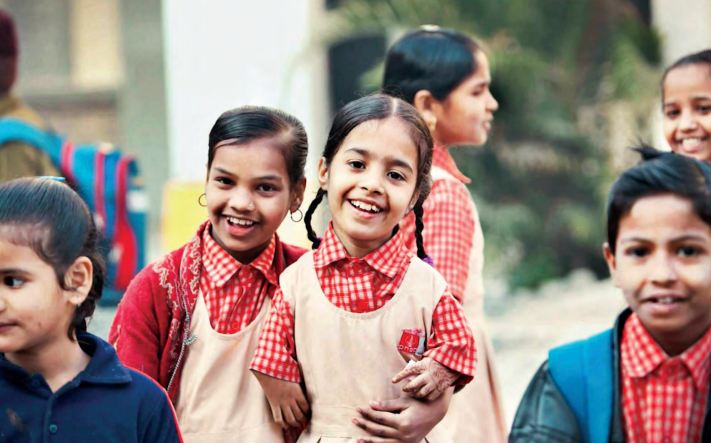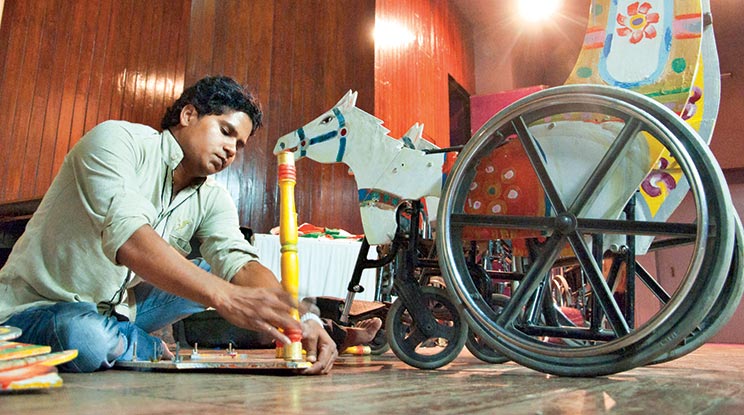Rallying Call for a Disability-Inclusive Society
Biz@India
May 2018
In a country where disability is often stigmatised, the differently-abled face a number of challenges – from lack of basic infrastructural facilities to sexual violence. Though both government and private players are recognising the need to focus on the differently-abled population, challenges remain.
Differently-abled and the elderly climbing steep steps with difficulty at the Cantonment Railway Station in the south Indian city of Bengaluru, Karnataka, is not a rare sight. The oldest railway station in the city lacks connectivity between its platforms, thus wheelchairs cannot transport people from one to another. On an average, over 120 trains halt at the station every day, yet the only connectivity between two platforms is a foot over bridge with a steep flight of stairs on either side with no lift or escalator.
According to railway employees, they have been asking for a trolley path for over seven years now because it is not just the differentlyabled who struggle, but passengers with heavy luggage, and middle-aged and elderly people, also have a tough time climbing up and down.
Not only Bengaluru but India’s capital city, New Delhi, also lacks amenities for the differently-abled. In a recent initiative, the league cricket team Delhi Daredevils invited the team’s differently-abled fans to enjoy the Indian Premier League (IPL) match at the Feroz Shah Kotla stadium on May 19.
However, the match had just two differently-abled spectators making it to the ground. While facilities inside the stadium have been upgraded as per the directives of Court of Commissioner (Disabilities) with ramp access to the seats, lifts to reach vertical levels and toilet accessibility; problems of accessibility to the stadium and absence of allocated parking area for differently-abled remain a hindrance.
Disability was not even covered in India’s census from 1941 to 1971. Persons with Disabilities (PwDs) remained excluded from the population census until 1980s. The 1981 census did include information on the disable population, but only recognising three types of disabilities.
Today, according to the latest census reports of India (updated in 2016), close to 2.21 pc of the population is suffering from one or other kind of disability. Amidst more than 1.3 billion people in the country, around 26.8 million are disabled.
The 2030 Agenda for Sustainable Development contains 11 explicit references to PwDs across several goals and targets, and expresses the need to address this significant group in order to stand a chance of achieving the United Nation’s Sustainable Development Goals (SDGs).
According to Sabine Rehbichler, the International Programmes & Advocacy Director at Light for the World, an international disability and development NGO aiming at an inclusive society, the Organisation for Economic Co-operation and Development (OECD) Development Assistance Committee (DAC) has reviewed the Common Reporting Standards against SDGs. It has set specific targets on inclusion of people with disabilities. It is important that newly introduced OECD DAC disability marker becomes operational as soon as possible and that inclusion of PwDs is no longer treated as a voluntary add-on.
Infrastructure
In India, Rights of Persons with Disabilities Act 2016, mentions that all institutions should ensure barrier free spaces, no discrimination and services for people with disabilities.
However currently, lack of disabled-friendly public infrastructure has left many dependent on their families or with a restricted commute. People with locomotor disabilities or visual and hearing impairments, who depend on buses or trains, are prone to minor accidents and falls for their daily commute.
PwDs are also particularly vulnerable to deficiencies in services such as health care, rehabilitation, and support and assistance. According to the World Health Organisation (WHO) research in Indian states of Uttar Pradesh and Tamil Nadu found that after cost, lack of services in the area was the second most frequent reason for people with disabilities not using health facilities.
However, with the vision of Accessible India Campaign launched in December 2015, the Union Ministry of Social Justice and Empowerment is in the process of making Delhi an accessible city for PwDs. For this, all government and private offices, cinema halls, parks, hospitals, police stations, tourist places, banks and ATMs, metro stations, post offices, courts, etc., will have spaces for differently-abled.
The central government has written to Delhi to come up with a plan to transform the capital into a model city for others to replicate. The Department of Persons with Disabilities has proposed the plan in making accessible parking, ramps, toilets, automated fare collection gate, kiosks, lifts at every entry/ exit, directional signage, audio announcements, etc., with all public buildings/places made accessible within a period of five years.
According to Nidhi Goyal, one of the authors of the Human Rights Watch report titled ‘Invisible Victims of Sexual Violence: Access to Justice for Women and Girls with Disabilities in India’, the current infrastructure in the country is not friendly for a person with a disability and being a woman adds to the difficulty. “When you are trying to move in the cities or navigate, then you have to ask for help and when you ask for help, you make yourself more vulnerable to any kind of inappropriate touch or some type of harassment,” Goyal says.
According to the report that was released in April this year, women and girls with disabilities in India are at a higher risk of sexual violence. According to Human Rights Watch, the government should set up a special phone line for women and girls to call if sexual violence happens to them and make sure women and girls with different disabilities can use this line.
While the authorities claim that the government budget this year aimed to enhance ease of living of the common man, disability rights activists say the community was excluded from this bracket.
The National Platform for the Rights of the Disabled (NPRD) issued a statement on the Union Budget 2018 calling it ‘a big disappointment’ for the disabled community. Muralidharan Vishwanath, NPRD general secretary, pointed out that during the nearly two-hour-long budget speech, the disabled community was merely mentioned twice without any specific details or schemes.
“It seems as though the disabled do not figure in the Finance Minister’s ‘fast growth economy’ trajectory,” the NPRD statement read. As compared to the previous budget, where the government had allocated USD 126 million for the department of Empowerment of Persons with Disability, this year’s budget has increased the amount it to USD 157 million. However, activists believe this is not enough.
Muralidharan asks, “Disability is not just empowerment of PwDs. It should be there in health, education and other departments. For instance, special schools come under the empowerment department. But other schools come under HRD and for making education accessible to persons with disabilities, what are the allocations being made?”
Ray of Hope
While many are ignorant towards the differently-abled, there are employers in the country who haven’t turned a blind eye towards them. More and more organisations in India are taking up Corporate Social Responsibilities (CSR) seriously and are contributing towards upliftment of the differently-abled people. Cafes, restaurants and retail outlets like Lifestyle, Kentucky Fried Chicken (KFC), Hyper City, Max, Dominos, Costa Coffee and Reliance retail, among others, are increasingly employing these people as cashiers, attendants, executives, store administrators and merchandisers.
Similarly, Larsen & Toubro – a construction company in India, with Leading Hotels Ltd in Goa, trains the youth in skills such as carpentry, masonry, plumbing, tiling, structural and pipe welding; while on the other hand, Mahindra and Mahindra runs Mahindra pride schools providing livelihood training to the socioeconomic disadvantaged communities. Furthermore, various organisations like Indian Association for the Blind and National Association of Software and Services Company (NASSCOM), amongst many others, provide BPO and vocational training as well as inject basic engineering skills into the disabled. Some public sector institutions like National Thermal Power Corporation and Bharat Heavy Electricals Ltd Also engage PwDs in various roles.
This potential in contributing to society has not gone unnoticed as many NGOs like Trust for Retailers and Retail Associates of India (TRRAIN) and Youth4Jobs are joining in to provide the disabled an opportunity to work. They are supporting the initiative by combining compassion and businesses to train the differently-abled population and making them fit to be able to work in the corporate world. “We train the youth with disabilities from poor homes, mostly from villages. They are taken through a 60-day module, which includes English communication, soft skills, life skills and digital literacy. Depending on their aptitude, education and aspirations we provide them a sector specific training like tally, hospitality, retail or IT enables services. Mornings begin with yoga and meditation and the sessions are fun-filled and interactive. We teach English through songs and for the speech and hearing impaired, we have sign language trainers. Companies participate in our trainings by giving guest lectures, videos and modules. They also hire them after the training is completed,” says Meera Shenoy, founder of Youth4Jobs Foundation, a non-profit NGO that sets up placement-linked skilling centres for youth with disability in India.
Though there are initiatives like these, PwDs face several challenges when looking for jobs or to develop employable skills. Even after the Persons with Disability Act 1995 in India mandates reservation for differently-abled in government jobs, the opportunities are still sparse. “Many companies in India are ignorant about inclusion and disability. There is a deep mindset that it is expensive to hire them. Along with this, the differently-abled youth have low selfesteem since their parents and society believe that they are useless and unemployable. The situation is worse if you are a girl,” explains Shenoy. Even after the government provides scholarships and fellowships to differently-abled students at various levels, more than 40 pc of all PwDs in India are illiterate and interestingly, even in Kerala, which has near-total literacy, nearly 31 pc of the PwDs are illiterate.
Poorest Areas Civil Society (PACS) launched its ‘skills.in’ programme aimed at offering vocational skills training to young people from Scheduled Castes, Scheduled Tribes and Muslim communities with disabilities. Similarly, the National Action Plan for skilling of PwDs has set a target to skill 500,000 differentlyabled annually – leading to 2.5 million PwDs being skilled by 2022. However, these trainings offered through various mechanisms are non-homogenous, lacks quality and is low on employability. Suffice to say that while a lot of initiatives are being undertaken by the Government of India and private entities, a lot more concrete action still needs to be taken to provide the differently-abled of the nation with basic access and amenities.











